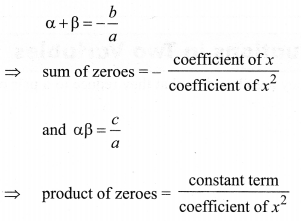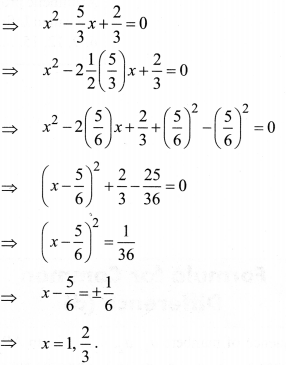Quadratic Equation
Standard form of the quadratic equation in the variable x is an equation of the form ax2 + bx + c = 0, where a, b, c are real numbers and a ≠ 0.
Any equation of the form P(x) = 0, Where P(x) is a polynomial of degree 2, is a quadratic equation.
Zero(es)/Root(s) of Quadratic Equation
A real number α is said to be a root of the quadratic equation ax2 + bx + c = 0, a ≠ 0 if aα2 + bα + c = 0.
We can say that x = α, is a solution of the quadratic equation or that α satisfies the quadratic equation.
The zeroes of the quadratic polynomial ax2 + bx + c = 0 and the roots of the equation ax2 + bx + c = 0 are same. A quadratic equation has atmost two roots/zeroes.
Relation Between Zeroes and Co-efficient of a Quadratic Equation
If α and β are zeroes of the quadratic equation ax2 + bx + c = 0, where a, b, c are real numbers and a ≠ 0 then
Methods of Solving Quadratic Equation
Following are the methods which are used to solve quadratic equations:
(i) Factorisation
(ii) Completing the square
(iii) Quadratic Formula
Methods of Factorisation
In this method we find the roots of a quadratic equation (ax2 + bx + c = 0) by factorising LHS it into two linear factors and equating each factor to zero, e.g.,
6x2 – x – 2 = 0
⇒ 6x2 + 3x – 4x – 2 = 0 …(i)
⇒ 3x (2x + 1) – 2(2x + 1) = 0
⇒ (3x — 2) (2x + 1) = 0
⇒ 3x – 2 = 0 or 2x + 1 = 0
Necessary Condition : Product of 1st and last terms of eq. (i) should be equal to product of 2nd and 3rd terms of the same equation.
Method of Completing the Square
This is the method of converting L.H.S. of a quadratic equation which is not a perfect square into the sum or difference of a perfect square and a constant by adding and subtracting the suitable constant terms. E.g,
(1) x2 + 4x – 5 = 0
⇒ x2 + 2(2)(x) -5 = 0
⇒ x2 + 2(2)(x) + (2)2 – (2)2 – 5 = 0
⇒ (x + 2)2 – 4 – 5 = 0
⇒ (x + 2)2 – 9 = 0
⇒ x + 2 = ± 3
⇒ x = —5, 1
(2) 3x2 – 5x + 2 = 0
Quadratic Formula
Consider a quadratic equation: ax2 + bx + c = 0.
If b2 – 4ac ≥ 0, then the roots of the above equation are given by:
Nature of Roots
For quadratic equation ax2 + bx + c = 0
(a ≠ 0), value of (b2 – 4ac) is called discriminant of the equation and denoted as D.
D = b2 – 4ac
Discriminant is very important in finding nature of the roots.
(i) If D = 0, then roots are real and equal.
(ii) If D > 0, then roots are real and unequal
(iii) If D < 0, then roots are not real.

No comments:
Post a Comment